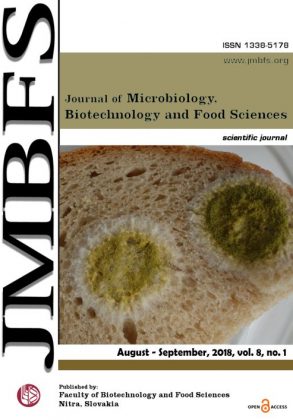CHARACTERIZATION OF MORINGA OLEIFERA LEAVES AND ITS UTILIZATION AS VALUE ADDED INGREDIENT IN UNLEAVENED FLAT BREAD (CHAPATTI)
DOI:
https://doi.org/10.15414/jmbfs.2018.8.1.751-755Keywords:
Micronutrient, food biodiversity, Moringa oleifera, chapatti, Antioxidant activity, pasting propertiesAbstract
Micronutrient deficiency is a major concern now a days as more than 30 percent of world’s population is suffering from nutritional deficiency. People are getting awareness regarding food biodiversity, therefore they demand value added and nutritionally enriched food products to counter appetite as well as to improve their health. This study was conducted to assess the nutritional potential of Moringa oleifera leaves powder (MOLP) and a product was developed to ensure its efficient utilization in chapatti (Unleavened flat bread). For this purpose proximate composition was analyzed for both moringa oleifera leaves powder and whole wheat flour (WWF). The depicted results for MOLP were as 10.75% moisture, 7.79% ash, 6.49% crude fat, 23.72% crude protein, 12.48% crude fiber. Afterward, raw materials were analyzed for mineral profile, MOLP showed better mineral content as; 1295 mg/100g K, 211.92 mg/100g Mg, 6.32 mg/100g Cu, 7.37 mg/100g Fe, 12.83 mg/100g Na, 6.3 mg/100g Zn and 8.67 mg/100g Mn, as compared to WWF. Then antioxidant activity of both materials was analyzed and again MOLP showed better results as compared to WWF. The recorded values for Total Phenolic Content (TPC), Total Flavonoid Content (TFC) and antioxidant activity of MOLP were as; 88.63 mg GAE/g, 30.86 mg CE/g and 89.27%, respectively. Furthermore composite flour blend was prepared with the addition of 5, 10, 15 and 20% MOLP in WWF and analyzed for pasting properties then chapattis ware developed and analyzed for mineral profile and antioxidant activity as well as sensory attributes. It was observed that chapatti with 20% MOLP contained highest level of minerals as; 286.07 mg/100g K, 147.75 mg/100g Mg, 5.12 mg/100g Cu, 4.09 mg/100g Fe, 12.83 mg/100g Na, 4.78 mg/100g Zn and 5.78 mg/100g Mn. Similarly the treatment with highest proportion of MOLP showed maximum antioxidant activity; TPC, TFC and DPPH depicted results 8.83 mg GAE/g Extract, 3.66 mg CE/ g of extract, 80.52% respectively. The sensory evaluation of chapatti exhibited that treatments which had 5 and 10% of MOLP demonstrated comparatively better results with overall acceptability scores 6.90 and 6.20, respectively, however T2 (10% MOLP) was the best acceptable combination regarding its sensorial attributes. Conclusively the micronutrient profile and antioxidant activity of chapattis gradually enhanced by increasing the level of MOLP.Downloads
Download data is not yet available.
Downloads
Published
2018-08-01
How to Cite
Sajid Mushtaq, B., V. Oseneva, O., S. Popov, E., N. Popova, N., P. Shchetilina, I., A. Derkanosova, A., Ali Shariati, M., Tufail, T., Bilal Hussain, M., Omer, R., Pasha, I., & V. Kharitonov, D. (2018). CHARACTERIZATION OF MORINGA OLEIFERA LEAVES AND ITS UTILIZATION AS VALUE ADDED INGREDIENT IN UNLEAVENED FLAT BREAD (CHAPATTI). Journal of Microbiology, Biotechnology and Food Sciences, 8(1), 750–755. https://doi.org/10.15414/jmbfs.2018.8.1.751-755
Issue
Section
Food Sciences
License
Copyright (c) 2018 Bilal Sajid Mushtaq, Imran Pasha, Rabia Omer, Muhammad Bilal Hussain, Tabassum Tufail, Mohammad Ali Shariati, Anna A. Derkanosova, Irina P. Shchetilina, Nadezhda N. Popova, Evgenij S. Popov, Olga V. Oseneva, Denis V. Kharitonov

This work is licensed under a Creative Commons Attribution 4.0 International License.
All papers published in the Journal of Microbiology, Biotechnology and Food Sciences are published under a CC-BY licence (CC-BY 4.0). Published materials can be shared (copy and redistribute the material in any medium or format) and adapted (remix, transform, and build upon the material for any purpose, even commercially) with specifying the author(s).





